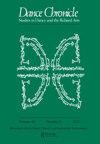对现代主义与现代性的再思考:一种舞蹈方法
IF 0.1
3区 艺术学
0 DANCE
引用次数: 0
摘要
拉姆西·伯特和迈克尔·赫胥黎的《舞蹈、现代主义和现代性》为我们理解舞蹈、现代性和现代性的关系做出了重要贡献。社会学家安东尼·吉登斯(Anthony Giddens)引用的“现代性”一词被定义为“对世界的某种态度,即通过人类干预,世界对变革开放的想法”(第26页)。根据伯特和赫胥黎的说法,这种对变化和转变的开放性体现在舞蹈带来“现代主义的多样性、流动性和矛盾性”的潜力上(第30页)。然而,在本书中,“现代主义”不再意味着“男性的、非规范的、坚定的文学性的、讲英语的”(第16页),而是以道格拉斯·毛和丽贝卡·沃尔科维茨在2008年的文章《新现代主义研究》中提出的“扩展”为特征,沿着三个轴——时间、空间和垂直——进行,通过这三个轴,作者对舞蹈是如何发展和回应现代生活体验的进行了多角度的分析。因此,伯特和赫胥黎的批评方法是避开早期关于舞蹈现代主义的著作,这些著作只关注形式和美学问题——比如马歇尔·科恩对苏珊娜·兰格的质疑,即舞蹈创造了一种征服重力的幻觉,是现代主义的体现——并试图对现代主义进行更广泛、更包容的解释。在克莱尔·沃登(Claire Warden)漫长而彻底的前言之后,这本由11篇文章组成的文集——伯特(Burt)的4篇,赫胥黎(Huxley)的3篇,以及他们两人的4篇——经过深思熟虑,分为两部分。第一部分由伯特和赫胥黎共同撰写,主要探讨这一时期舞蹈的现代性和现代性的关键因素和问题,第一章为绪论。第2章集中于20世纪初至50年代中期现代舞的历史(时间轴)考量。作者本文章由计算机程序翻译,如有差异,请以英文原文为准。
Rethinking Modernism and Modernity: A Dance Approach
Ramsay Burt and Michael Huxley’s Dance, Modernism, and Modernity offers an important contribution to our understanding of the nexus of dance, modernism, and modernity. The term “modernity,” cited from sociologist Anthony Giddens, is defined as “a certain set of attitudes towards the world, the idea of the world as open to transformation, by human intervention” (p. 26). This openness to change and transformation, according to Burt and Huxley, is exemplified by the potential of dance to bring about “the diversity, fluidity, and contradictions of modernism” (p. 30). However, in this book, “modernism” no longer connotes “male, heteronormative, resolutely literary, Anglophone” (p. 16), but is characterized by the “expansion” proposed by Douglas Mao and Rebecca Walkowitz in their 2008 article “The New Modernist Studies.” Such an expansion, “in terms of discipline, geography, definition and identity” (p. 18), takes place along three axes—temporal, spatial, and vertical—through which the authors conduct a multiple-angled analysis of how dance has developed and responded to the experience of living in modern times. Thus Burt and Huxley’s critical approach is to eschew early writings on modernism in dance that are concerned solely with formal and aesthetic issues—such as Marshall Cohen’s questioning of Susanne K. Langer’s claim that dance creates the illusion of the conquest of gravity as an embodiment of modernism—and attempt to develop a wider and more inclusive interpretation of modernism. After the lengthy and thorough foreword by Claire Warden, this collection of eleven essays—four by Burt, three by Huxley, and four by them both—is thoughtfully organized into two parts. Part 1, co-written by Burt and Huxley, is concerned with key factors and issues about modernism and modernity in dance during the period, with chapter 1 serving as the introduction. Chapter 2 centers on a historiographical (temporal axis) consideration of modern dance from the early 1900s to the mid-1950s. The authors
求助全文
通过发布文献求助,成功后即可免费获取论文全文。
去求助
来源期刊

DANCE CHRONICLE
DANCE-
CiteScore
0.40
自引率
0.00%
发文量
22
期刊介绍:
For dance scholars, professors, practitioners, and aficionados, Dance Chronicle is indispensable for keeping up with the rapidly changing field of dance studies. Dance Chronicle publishes research on a wide variety of Western and non-Western forms, including classical, avant-garde, and popular genres, often in connection with the related arts: music, literature, visual arts, theatre, and film. Our purview encompasses research rooted in humanities-based paradigms: historical, theoretical, aesthetic, ethnographic, and multi-modal inquiries into dance as art and/or cultural practice. Offering the best from both established and emerging dance scholars, Dance Chronicle is an ideal resource for those who love dance, past and present. Recently, Dance Chronicle has featured special issues on visual arts and dance, literature and dance, music and dance, dance criticism, preserving dance as a living legacy, dancing identity in diaspora, choreographers at the cutting edge, Martha Graham, women choreographers in ballet, and ballet in a global world.
 求助内容:
求助内容: 应助结果提醒方式:
应助结果提醒方式:


